
|
The Liquefied Natural Gas Shipping Market
in 2002
|
The fleet
New developments
Ship prices
The projects
U.S. market
Other developments
Summary
|
|
2002 ended more or less as it ended in 2001 with
a major U.S. energy player in difficult financial circumstances. The previous year closed with
the demise of Enron and El Paso would appear to be repeating the show this year, although with
nowhere near the same implications. Last year in this report we mentioned 'd'j' vu' with
reference to El Paso, who have now chartered-in five new Daewoo ships from Exmar / MOL.
However, we were not to know how far our 'd'j' vu' statement would
stretch, as El Paso have again fallen foul to a general malaise within the energy companies in
the U.S.. Their U.S. gas pipeline operations may survive, but it looks increasingly as if they
may fall out of LNG again.
Apart from the now familiar U.S. energy company problems, Williams, CMS. Reliance' the LNG
market in 2002 has seen both a shortage of cargoes and ships. Whilst most activity over recent
years has focused on the U.S. market absorbing all of the surplus available cargoes recent
Asian activity has seen the balance shift back eastwards. The Japanese demand increased in the
last quarter due to nuclear safety concerns causing the shutdown of 7 Tepco nuclear plants.
Korean winter demand also saw a market request for up to a further 36 cargoes. These two events
led to all of the producers trying to increase their output to meet this demand from their
traditional customers.
Unfortunately, this Tepco demand coincided with some plant shutdowns at Das Island alongwith
some turbine problems on the Abu Dhabi fleet that was restricting schedules. Cargoes previously
sold on a short term basis to European buyers were then re-directed towards the east where
higher prices were achieved. Most recently we have even seen cargoes sold from Algeria to
Kogas: Sigtto's LNG Log for 2002 should prove interesting reading!
And if the LNG shipping market was not tight enough, a U.S. submarine decided to raise its
periscope into the double-bottom of the 'Norman Lady' necessitating her withdrawal from
service for repairs.
|
| The Fleet |
|
|
In 2002, the LNG fleet has increased to 137, and
by the end of the year there was an additional 56 ships on order!
|
Small:
|
capacities from 18,000 to 50,000
cbm
|
Total: 16
|
|
Medium:
|
capacities 51,000 to 100,000 cbm
|
Total: 15
|
|
Large:
|
capacities above 100,000 cbm
|
Total: 106
|
Vessel size has been slow to increase but 2002
did see the market considering the use of large 200,000 cbm ships for the longer haul dedicated
routes that are planned. Depending upon how the shipyards price these new large units there
could be transportation costs savings in the region of 10-15 %.
Membrane technology continues to lead the orderbooks with 64 % of the vessels on order
featuring the GTT membrane. A new type of membrane system was added to the GTT portfolio when
Gaz de France ordered the first CS1 vessel. The CS1 offers increased cargo capacity without
increasing the external dimensions of the ship.
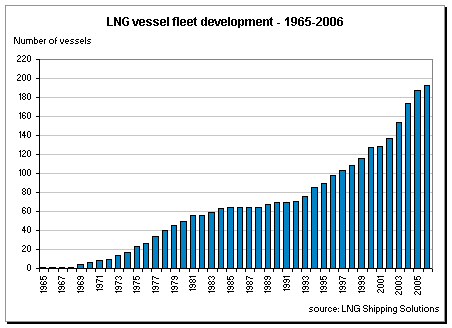
The breakdown on the fleet in terms of
containment sytem is:
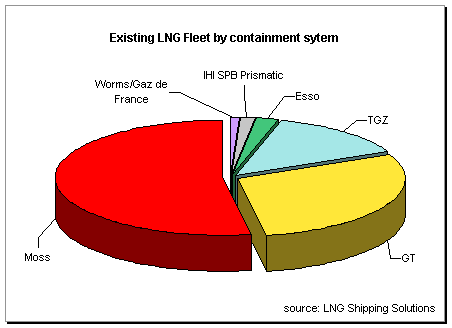
In addition there are a further 56 ships on
order, or some 40 % increase, a truly remarkable statistic!
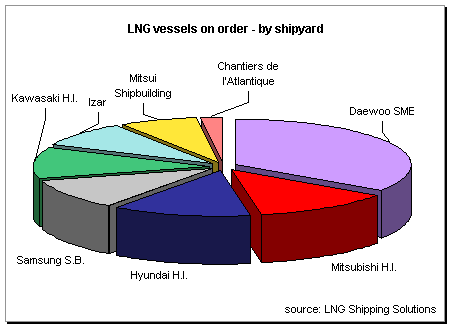
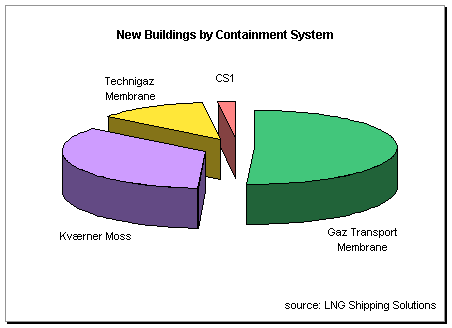
The spate of speculative orders that prevailed
in 2000 does not seem to be repeated with all new orders being placed against firm contracts.
What does seem to be changing however is the duration of the charters. Two of the Snohvit
charters that were confirmed earlier this year have 12 and 8-year commitments and the recent
GdF tender has asked for a possible 12-year charter period. This reduction from the typical 20
year charter would suggest a reflection in matching the charter period to that of the sales
contract and/or careful attention by charterers to their balance sheets.
The age of the LNG fleet is also causing concern to some LNG members especially in the light of
the major pollution incidents involving old tankers : notably the 'Erika' and the 'Prestige'.
Both of these ships were carrying fuel oil cargoes, fuel typically used in power generation,
and synergies with the LNG market should not be ignored. Fuel oil is a competing fuel to the
emerging gas-fired power generators and fuel oil is one of the elements in most LNG pricing
formulae. Any change in the circumstances surrounding the fuel oil cost will impact on LNG
pricing, but phasing out of old fuel oil carriers may see a similar phase out of old LNG
carriers, despite the industry's excellent safety record.
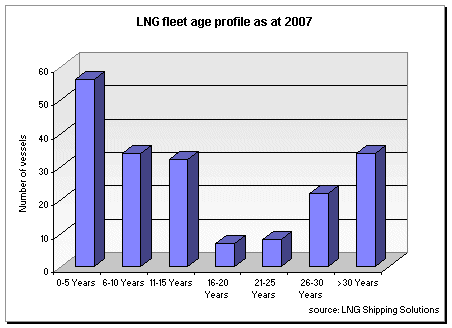
It should not be forgotten that all LNG carriers
today use fuel oil as bunkers to supplement the boil-off gas in powering the vessels. So whilst
the LNG cargo is eco-friendly the bunker fuel is not. The risk of pollution still exists on the
LNG vessels, not necessarily from marine accidents (collision with tugs for example) but during
the more routine operation of bunkering from barges in what are typically sensitive areas.
The oldest LNG ships is the 'Cinderella', built 1964, that was initially sold for scrap but
somehow escaped some 14 years ago, and the 'Hoegh Galleon', built 1974, was also sold for
scrap but re-emerged with a new life after the tanks were repaired, are two examples of aged
vessels that are lucky to still trade LNG today. However, these two vessels trade extensively
into Spain, a country that is currently closely looking at the age of tonnage in its
territorial waters.
|
|
|
Fernando Tapias
140 500 m3, livr' en 2002 par Daewoo, propri't' de Tapias F. Naviera.
|
| New Developments |
|
|
Gaz de France broke the traditional mould in
2002 when the first diesel-electric propulsion ship was ordered from Chantiers de l'Atlantique.
This 74,000 cbm vessel is due for delivery in end 2004. However, not only was a new propulsion
system selected, a new type of membrane containment system will also be used. This CS1 system,
a hybrid of the two existing membrane technologies GT96 and TGZIII, offers significant cost
savings for the builder and optimises cargo capacity for the owner / charterer.
In light of the diesel-electric order there has
been a surge in interest expressed in what is alternative propulsion to the steam turbines.
This is partly due to the change in the LNG trade, where the emergence of a spot market demands
the maximum amount of cargo is delivered to the customer (not usually the case in the
traditional annual delivery concept) but also the recent troubles associated with gearboxes on
some recently built turbine ships.
Gas turbine manufacturers have also turned their
attention to LNG in the wake of a downturn in aircraft orders. Once thought extremely expensive
it would now appear that market conditions have seen a more sensible approach to pricing.
|
| Ship Prices |

|
|
Whilst LNG newbuilding prices had generally been
on the increase, but nowhere near the previous highs, the competitive market would seem to have
returned with yards, especially the Korean shipyards, seeking new LNG orders. There are at
present two tenders for new tonnage on the market and it will be interesting to see at what
level the bids are set.
The graph shows the trend of pricing, with a comparison to VLCC prices, over recent years.
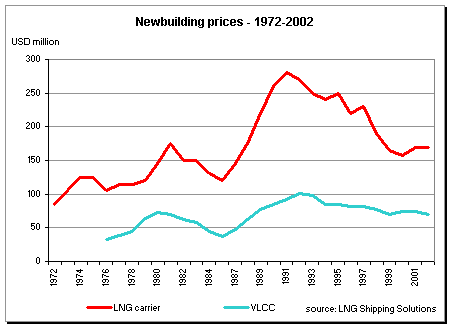
The yards are in general seeking orders for all shipping and those that specialise in LNG also
build other types of ships. However, those orders are also drying up but a knee-jerk reaction
in the aftermath of the 'Prestige' could see this change. A recently reported price war
between two Korean yards seeking to secure an order for containerships could see this translate
into the LNG market. There are already rumours of prices falling to the level set some three
years ago when the Spanish orders were placed.
Will the E.U. relaxation on yard subsidies increase price competition? Will inventive tax
incentives continue within Europe? If the answers to these questions are yes, then ships prices
will remain low for the foreseeable future.
|
| The projects |
|
The Norwegian project, Snohvit,
finally received the final go ahead but not without opposition. Between the EU Council in
Brussels and the environmentalists in Norway the pressure was very much against the
project. However, in the end common sense prevailed and the project was eventually given
the 'green light' in June. Some of the project partners were also instrumental in
changing the future of LNG when TotalFinaElf and GdF elected to take their equity gas as
fob cargoes using their own ships.
Angola did not make the progress anticipated, but although no progress was made in
2002 there should be some good news by the end of 2003. There has been a recent
development in the Angola LNG project that may see an advance in the start-up date. Whilst
the project was restructured earlier in the year with a new partnership agreement
following the end of the civil war (which enabled a change in site location at least) and
the Chevron / Texaco merger, that resulted in some slip in the original schedule, the
Angolan government is taking a stand. They have slowed the pace of approvals for
deep-water oil projects to synchronise with a 2007 launch of the LNG project, which could
be interpreted as no LNG, no oil ! The real concern in Angola is the reduction of gas
flaring which at present stands at about 85 % of its gas, and any increase in oil
production would naturally increase the flaring. Political sensitivities could also be
influential where the United-States are looking for diversification away from the
dependency on the Middle East and thus investment in the African continent may be a
necessity of Washington rather than the oil companies.
There is continued discussions on Iran LNG from the South Pars field, but given
continued threat of hostilities in that region there will be continued uncertainty on this
project. Furthermore investment in 'green field sites' is always the most difficult
aspect of a project when the long-term buyers are no longer there. The main competition
for Iran is the existing LNG operations in Qatar which appear to have the ability
to expand at very short notice. The infrastructure at Ras Laffan will always give Qatar a
commercial lead against a new project that will be stretched for capital investment.
The same problems exist in Yemen as for Iran, except that the threat of terrorism
is more real in that region. LNG projects require huge investment and financial
institutions will always assess the risk to their investment, always choosing the least
risk. Thus allocating funds to Qatar or Oman expansions, for example, is
always easier than start-up projects in sensitive political arenas.
Egypt is finally realising the ambition of being an important LNG player with the
final agreement for its second LNG project. GdF signed an agreement to purchase the entire
output from the first train of the BG led consortium and now BG is actively pushing for
expansion of the second train, which is now expected in early 2006.
There is however greater emphasis on African projects, apart from Angola and Nigeria LNG,
as the USA seeks non-Arab sourced hydrocarbons. There is at least one more Nigerian
project at the planning stage and another in Equatorial Guinea. Both of these
projects will be seeking the 'Americas' market.
The main activity in the increase in LNG
production capacity involves expansion schemes in existing LNG plants. We have seen
Nigeria LNG, Atlantic LNG, Qatargas and RasGas, Australia LNG and MLNG all develop
expansion schemes.
Financing is always the key to a successful
project and that typically requires firm long term contracts from gas buyers.
Unfortunately, some of the new gas buyers are not in a position to guarantee their
off-take quantities, Dabhol and Petronet in India being prime examples, and so new
projects seeking similar markets struggle to attract finance, unlike those existing plants
who already have significant cash flows.
|
| U.S. Market |
|
|
The US market remains the biggest potential
target for future LNG growth. Domestic supply of gas is diminishing whilst long term demand,
from the power sector, continues to grow. With only four existing terminals there is a finite
capacity of about 16 million tonnes with a further 12.3 million tonnes expansion planned, and
all on the East coast.
There are several projects for new terminals in the Baha peninsula of Mexico plus two for the
Gulf of Mexico but now there is the likelihood of a new terminal in northern California, a
concept many thought impossible not long ago. The regional demand is highest in California but
the slim prospect of siting a terminal there caused the rush for the Baha peninsula. However,
it now seems that reality has beaten off unjustified fear and the move is on to build a
Californian terminal. We should know more on this by the end of 2003.
The Bahamas is another favoured location to site a receiving terminal, Tractebel having bought
the old Enron site in the West, with El Paso holding onto its proposed site, in the East, for
the moment. The advantage of the Bahamas is the proximity to the Florida market.
Despite new security measures having been introduced to the Boston harbour where Tractebel's
Everett terminal is located, LNG is expected to continue to be imported into the New England
area. Whether this would continue should Irvine's new proposed terminal for Nova Scotia get
approval is still unknown. The continued threats of terrorist attacks hold a cloud over the
continuance of the Everett terminal, which is close to Boston city centre and at the end of
Logan Airport runway. Not that LNG offers any greater danger to the city compared to LPG, oil
or chemical carriers.
The long-awaited re-opening of the Cove Point terminal should occur in the third quarter of
2003. New owners, Dominion Energy, having acquired the terminal from Williams, have three
customers BP, Shell and the new user Statoil who recently purchased El Paso's capacity at
this terminal, along with its SPA from Snohvit.
With the forecast for U.S. gas prices around the $4.00 per mmbtu, the U.S. market should
continue to be the stimulus for many LNG projects and if the West coast terminals come into
existence then the Asian producers should also become involved in this market, rather than just
the Middle East and African producers.
There would also seem to be the prospect of more new terminals on the East coast of the U.S.
with Federal Energy Regulatory Commission (FERC) apparently relaxing the tight reins on
approval of new sites.
|
| Other
Developments |
|
|
We have previously referred to the fleet age
profile, old-ship disasters and the arrival of alternative propulsion. Larger size vessels, of
up to 200,000 cbm, are under consideration by ExxonMobil and TotalFinaElf for their new
proposed long-haul trades from Qatar whilst 145,000 cbm would appear to be the optimum size for
new orders today. The 145,000 cbm size is more or less the maximum size acceptable to all
existing terminals and as flexibility is very much the key focus on modern LNG trade any
increase in this size is not expected in the near future, unless the new CS1 containment system
gains wider use. The main advantage of the CS1 is the increase in cargo capacity for no change
in external dimensions of the vessel.
As for the age profile, we would seriously question the industry's love affair with old
tonnage when the rest of the shipping industry is looking carefully at the age of ships.
Furthermore, with increased efficiency of the modern tonnage and the possibility of wider use
of electric propulsion coupled with relatively low new ship prices, the case for fleet renewal
should be given wider consideration.
|
| Summary |
|
|
LNG shipping will continue to grab headlines in
the near future, hopefully for good reasons rather than adverse incidents such as the 'Norman
Lady' accident with a U.S. submarine. The fleet size is growing at a rate previously unheard
of and with 137 active and 56 on order the magical figure of 200 ships should be reached by
2007. As the new chosen preferred fuel for the future, the growth in LNG trade should continue
and with it the LNG shipping industry.
Evolution cannot be ignored and for LNG this will be shorter charter periods, more flexible
trading routes with less 'tram-line' operations. There should be progression towards
alternative propulsion away from the very high fuel consumption represented by steam turbines,
and this may be hastened after the delivery of the Gaz de France 74,000 cbm in 2 years time
that will be fitted with a diesel-electric engine. It will be worth noting the pioneer's
effect this new technology will have on the market.
New ship prices are expected to remain about the present level and stay there for the future
with the anticipated arrival of the Chinese yards entering the 'club' in 2006. It should
not be forgotten that it was the emergence of the new 'members' in Korea that assisted in
the fall of LNG prices in the mid'90's.
|
Shipping and Shipbuilding Markets in 2002
I N D E X
|